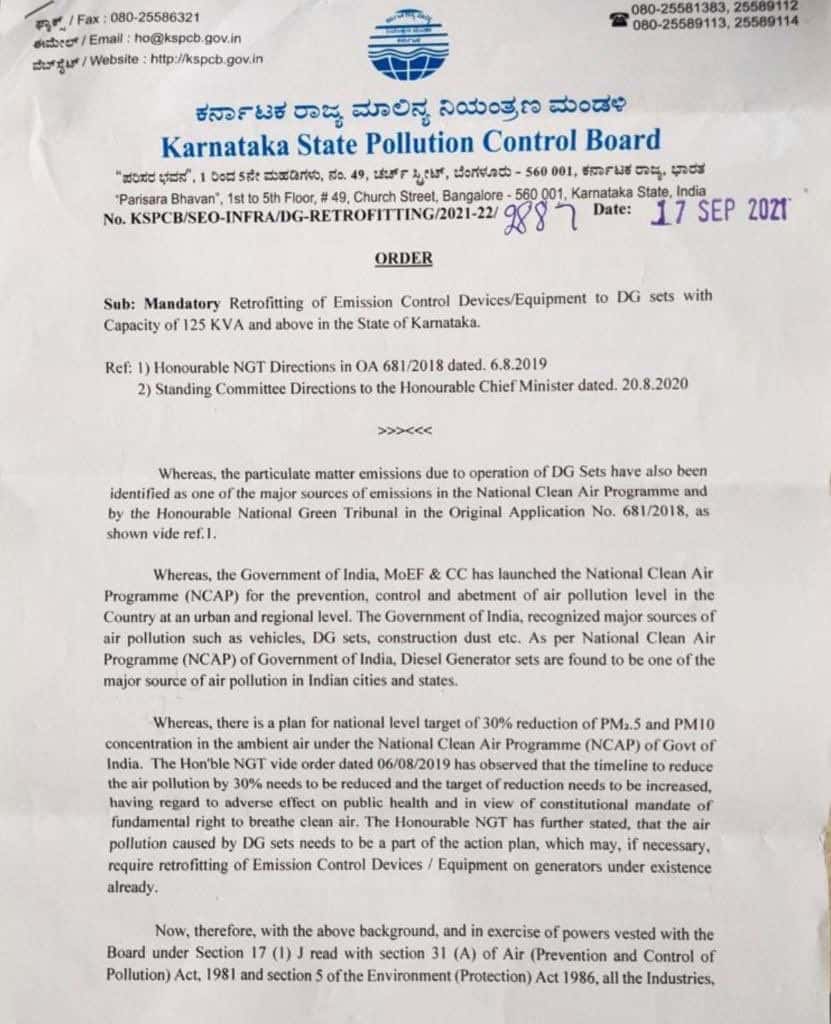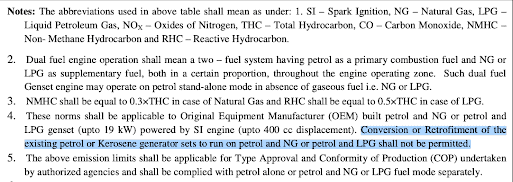Rarely do government circulars not raise a controversy. And the latest one by the Karnataka State Pollution Control Board (KSPCB) is no exception.
The circular mandates “Retrofitting of Emission Control Devices/Equipment to all Diesel Generator (DG) Sets with Capacity of 125 KVA and above in Karnataka”. Based on a National Green Tribunal (NGT) order on controlling air pollution, the circular specifies a minimum mandated Particulate Matter capturing efficiency of at least 70%, with a corresponding increase in fuel efficiency.
The order makes it compulsory for DG users to get their emission control devices certified by one of five laboratories empanelled to issue such certification (see screenshot below). Or shift to gas based generators or retrofit existing DGs for partial gas usage. All this to be completed within 120 days.


The reaction was immediate from the Bangalore Apartments Federation. “We understand the air pollution DGs create and are really concerned about it,” said Vikram Rai, general secretary. “But we don’t think and hence don’t agree that retrofitting existing DGs or switching to gas-based generators are the right solution. Apartment complexes are using DGs with capacity 125 KVA or above mainly to operate STPs, lifts and other essentials without interruption and ensuring security during power cuts in night hours. We apartments are more than happy to not run DGs if sufficient uninterrupted power is made available to us to operate STPs and ensure security”.
Read more: Clean air plans ready for 102 cities, but no budget
Strangely, whilst NGT and KSPCB in their respective order/circulars are mandating retrofitting or shifting to gas based generators, a MINISTRY OF ENVIRONMENT, FOREST AND CLIMATE CHANGE NOTIFICATION, Dated 7th March, 2016 Point No. 4 of 95C to Schedule I of the Rules on emission norms relating to Genset run on Diesel and Natural Gas (NG) or Diesel and Liquid Petroleum Gas (LPG) specifically prohibits conversion/retrofitment of DG sets for partial gas usage.

Ground reality
According to a letter dated April 20th, 2020 from generator manufacturer Cummins Sales and Service India, “The order of the Hon’ble NGT states that the retrofitment device shall be the type approved by any one of the five labs recognised by CPCB. However, according to our knowledge, no device has been approved by any one of the five labs nor are we aware of certification procedures released by CPCB in this regard.”
According to a letter to KSPCB, dated October 7th, 2021 from DG manufacturers and Indian Diesel Engine Manufacturers’ Association (IDEMA) “CPCB has recently drafted a system and procedure for genset retrofit which is still under review. Until the system and procedure document is officially notified, certified solutions or gas-based genset solutions, duly type approved by CPCB certified labs, cannot be provided to end customers. We are also working with CPCB on formulating a timeline for implementation so that the retrofit kit suppliers have adequate time to certify their solutions and ramp up the supply chains to have solutions available in the market by the time the norms come into effect.”
This letter was procured by Citizen Matters from the Bangalore Apartment Federation. IDEMA did not respond to requests for their views on this.
Why the order?
Data generated from the National Air Quality Monitoring Programme (NAMP) over the years reveal that reducing particulate matter (PM10 and PM2.5) which are exceeding the National Ambient Air Quality Standard (NAAQS) is the major challenge. According to the NCAP section 7.5.3 INDUSTRIAL EMISSION DG sets: 91% of DG Sets have no regulations beyond the point of manufacture. Studies show that as DG Sets get older, they might emit 11 times the standards set for manufacturers. Overall, DG Sets contribute to 7-18% to the ambient air pollution in non-attainment cities. According to TERI’s 2016 report, the share of overall residential combustion is 39% and DG/agricultural pump sets is 15%.
| Date | Action | Remarks |
| 2000 | THE NOISE POLLUTION (REGULATION AND CONTROL) RULES, 2000 | MINISTRY OF ENVIRONMENT & FORESTSThe Noise Pollution (Regulation and Control) Rules, 2000;(As amended till 10/08/2017 vide S.O. 2555(E)) |
| 2016 | TERI’s inventory (Sharma and Kumar, 2016) | PM emissions 2.5 are dominated by industrial (36%) and residential combustion (39%) sectors. Transport contributes just 4% of PM2.5 emissions at the National scale, however, these emissions are concentrated in urban centers. Moreover, being ground-based sources, their contribution to prevailing air quality levels could be much higher. Hydrocarbon emissions are mainly generated from biomass combustion activities in the residential sector. |
| Jan 2019 | India launched its National Clean Air Programme (NCAP) | Aim to achieve a 20-30% reduction in particulate matter (PM) concentration by 2024. |
| Aug 2019 | NGT ORDER oa 681/2018 dated 06.08.2019 | We note that the air pollution caused by DG Sets needs to be part of the action plans which may, if necessary, require retrofitting of emission-control devices on generators already in use. The NCAP itself provides following action points: CPCB may consider this aspect : Pt 4. Elimination of DG set usage by provision of 24×7 electricity. Pt 5. Evolve standards and norms for in-use DG sets below 800 KW category. Pt 6. For DG Sets already operational, ensure usage of either of the two options: (a) use of retrofitted emission control equipment having a minimum specified PM capturing efficiency of at least 70%, type approved by one of the 5 CPCB recognized labs; or (b) shifting to gas-based generators by employing new gas-based generators or retrofitting the existing DG sets for partial gas usage |
| Sept 2021 | KSPCB Circular | Mandatory Retrofitting of Emission Control Devices/Equipment to all DG Sets with Capacity of 125 KVA and above Karnataka. |
Way forward
According to the Draft Electricity (Rights of Consumers) Amendment Rules 2021 Section 10.3: “In view of the increasing pollution level particularly in the metros and the large cities, Distribution Licensee shall ensure 24×7 uninterrupted power supply to all consumers, so that there is no requirement of running Diesel Generating sets”. The draft rules also ask State Electricity Commissions to provide for penalties if power distribution companies fail to comply.
Read more: Study explores best practices to save electricity in Bengaluru’s apartments
It further states that consumers, who are using the DG sets as essential backup power, shall endeavor to shift to cleaner technology such as renewable energy with battery storage, etc in five years from the date of the publication of this amendment. Or as per the timelines given by the State Commission for such replacement based on the reliability of supply by the distribution company in that city.
How much fuel are apartment complexes consuming?
Sample survey of diesel consumption for 125kv DG and above in apartment complexes across Bengaluru, due to power disruptions:
| Number of apartment complexes | Seven |
| Total hours of power cuts | 140 hours avg across the city (lowest 72, highest 230 hours!) |
| Litres | 15367 |
| Amount* | Rs.14,22,528/- |
| Time frame | January – Oct 15, 2021 |
The amount which should have gone to BESCOM is going to oil companies at 256% tax instead!
According to Syed Khaja, KSPCB Senior Environment Officer, KSPCB has given six months time for consumers to comply, and will first start with the higher capacity DG sets – 1000 kVa/1MW, etc and then to lower capacity DG sets. As the availability of the components improve, the cost is likely to come down which will make it affordable for smaller capacity DG sets to implement.
As for the mechanism to implement, the Electrical Inspectorate is likely to be roped in to monitor compliance. On the question of whether there was any objection by either manufacturers or consumers, Khaja said KSPCB has not received any complaints so far.
On November 16th, 11 am, KSPCB is conducting a stakeholder meeting on the new guidelines related to sewage treatment. The agenda includes retrofitting of DG sets. CREDAI (Confederation of Real Estate Developers Association of India), BAF, Karnataka Urban Water Supply and Drainage Board (KUWSDB), Urban Development Department, IISC’s Department of Sustainability Technologies, and Chief Engineer at Minor Irrigation Department, will participate.